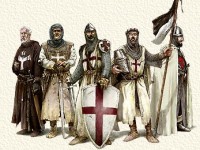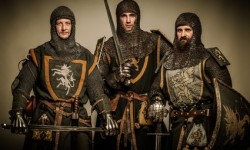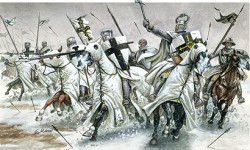In the 11th century, the Seljuk Empire spread over much of the Middle East as far as Pakistan. In 1071, the Seljuk leader Arp Arslan destroyed the Byzantine army and conquered the holy cities of Mecca and Medina. In 1073, the conquest of the city of Jerusalem followed. This was at the time in Islamic hands, but the event forced the Byzantines, however, to ask Pope Urban II for support against the Seljuk Turks to reconquer the holy places.
The Pope followed the request for help and called in Europe to the fight of the religions to protect the Christianity from the "godless pile". It was followed by the crusades we know.
Spurred on by the promise of perfect indulgence for all sins, thousands of the new movement joined. Characterized by a red cross on her clothing, the attachment to her belief should be made known. The prospect of prey and land was a negligible side effect.
Thus around 100,000 soldiers gathered at Constantinople. Most were from France, consisting of cavalry and infantry. Due to the poor supply and the soldiers hostile land, came in the march already most soldiers by water shortage and hunger, so that 1097 only 40,000 man reached the heavily fortified city of Antioch, which fell on June 3, 1098 after siege.
After the conquest of Antioch, the army, which had been decimated to 12,000 troops, moved on to Jerusalem. There, the fortifications could be overcome after a few months, taken the city and carried out bloody revenge on the population in a rush of victory.
After this victory, it was necessary for the Crusaders to divide the territories among themselves. Thus, smaller states such as the county of Edessa in Armenia, the Principality of Antioch in Syren or the Kingdom of Jerusalem. To protect the conquered territories, the new rulers decided to found a "Military Order" that would combine knightly ideals with monastic life. As namesake, the temple was selected in Jerusalem, so that the Order then received the name "Knights Templar".
In addition to the military tasks to protect the surrounding areas, the Order was also used more and more as an escort for pilgrims on their travels and for the fortifications of the cities.
These could be held for a time by the strong presence of the Knights Templar, but on open ground, the weak point of the deployed soldiers quickly became apparent. Thus, the heavy armor in the heat of the Middle East proved not only inflexible and tiring, the wearers were far inferior to the fast riders of the Seljuk Turks in maneuverability and so the fast Turkish riders could inflict heavy losses on the Knights Templar, which later on should turn out as a war decisive.
The recapturing of the County of Edessa in 1144 by the Seljuk Turks was a real shock to the Crusaders and the other occupied territories. Quickly voices were loud, which called for a second crusade. However, this was only heard after the French Abbot Bernard of Clairvaux, the French King Louis VII and the German King Konrad III. joined the call. An army was quickly set up to support the Knights Templar stationed in the Near East. On the way from Constantinople to Palestine in 1147, the army of the German King Konrad III. a bitter defeat and had to join with his remnants the French army. Due to disputes between the newcomers and the established crusaders, the second crusade was more difficult. so the siege of Damascus had to be stopped in 1148 and the second crusade ended as it had begun: in chaos.
Instigated by the internal disputes of the European ruling houses and the ignominy of a second invasion in the Middle East, the Kurdish leader Salah-al-Din, called Saladin, led the Muslims under the umbrella of the "Jihad" to counter the Christians and their final expulsion the Middle East.
You can find the right literature here:
The Concise History of the Crusades

The Concise History of the Crusades (Critical Issues in World and International History) Third Student Edition
What is the relationship between the medieval crusades and the problems of the modern Middle East? Were the crusades the Christian equivalent of Muslim jihad? In this sweeping yet crisp history, Thomas F. Madden offers a brilliant and compelling narrative of the crusades and their contemporary relevance. Placing all of the major crusades within their medieval social, economic, religious, and intellectual environments, Madden explores the uniquely medieval world that led untold thousands to leave their homes, families, and friends to march in Christ’s name to distant lands. From Palestine and Europe's farthest reaches, each crusade is recounted in a clear, concise narrative. The author gives special attention as well to the crusades’ effects on the Islamic world and the Christian Byzantine East.
The Crusades: The Authoritative History of the War for the Holy Land
The Crusades is an authoritative, accessible single-volume history of the brutal struggle for the Holy Land in the Middle Ages. Thomas Asbridge—a renowned historian who writes with “maximum vividness” (Joan Acocella, The New Yorker)—covers the years 1095 to 1291 in this big, ambitious, readable account of one of the most fascinating periods in history. From Richard the Lionheart to the mighty Saladin, from the emperors of Byzantium to the Knights Templar, Asbridge’s book is a magnificent epic of Holy War between the Christian and Islamic worlds, full of adventure, intrigue, and sweeping grandeur.
The Glory of the Crusades
How can the Crusades be called “glorious”? Our modern mindset says they were ugly wars of greed and religious intolerance—a big reason why Christians and Muslims today can’t coexist peacefully.
Historian Steve Weidenkopf challenges this received narrative with The Glory of the Crusades. Drawing on the latest and most authentic medieval scholarship, he presents a compelling case for understanding the Crusades as they were when they happened: “armed pilgrimages” driven by a holy zeal to recover conquered Christian lands. Without whitewashing their failures and even crimes, he debunks the numerous myths about the Crusades that our secular culture uses as clubs to attack the Church.
In place of these myths he offers men and women of faith and valor who pledged their lives for the honor of Christ’s holy places. With a storyteller’s gift, Weidenkopf relates the Crusades’ many dramas—their heroes and villains, battles and sieges, intrigues and coincidences—offering a vivid and engrossing account of events that, though centuries old, have profoundly affected the course of our world to the present day.
The Crusades: A History From Beginning to End
The Crusades are the prototype and epitome of the Holy War. The fight to take control of the city of Jerusalem, believed to be the most sacred Holy City to two distinct religions of Christianity and Islam, has lasted far longer than the two centuries of the Crusades and its reach has extended far further than Europe and the Middle East. Over the course of nine organized campaigns and many more unorganized ones, the Christian west militarized in the name of God to push back the threat of Islam advancing from the east.
This post is also available in:
 Deutsch (German)
Deutsch (German)  Français (French)
Français (French)  Italiano (Italian)
Italiano (Italian)  简体中文 (Chinese (Simplified))
简体中文 (Chinese (Simplified))  Русский (Russian)
Русский (Russian)  Español (Spanish)
Español (Spanish)  العربية (Arabic)
العربية (Arabic)



















